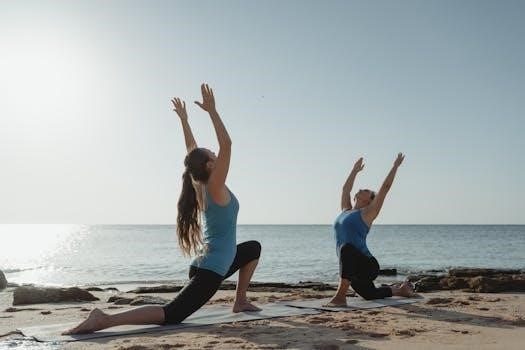spinal stenosis exercises pdf
Understanding Spinal Stenosis
Spinal stenosis is a condition characterized by the narrowing of the spinal canal, which can compress the spinal cord or nerve roots․ This narrowing is often due to age-related changes like arthritis, causing back and leg pain․ It can lead to various symptoms like tingling and muscle weakness, and can be managed effectively with exercises․
What is Spinal Stenosis?
Spinal stenosis is a medical condition involving the narrowing of the spaces within your spine, which can put pressure on the spinal cord and the nerves that travel through it․ This narrowing often occurs in the lower back (lumbar spine) or the neck (cervical spine)․ It’s typically caused by age-related changes, such as arthritis, spinal disc changes, and bone spurs․ This compression can lead to pain, numbness, muscle weakness, and other neurological symptoms․ Managing it often involves a combination of exercises and other conservative treatments to relieve pressure and improve mobility․

Common Symptoms of Spinal Stenosis
Common symptoms include back pain, leg pain, tingling, muscle weakness, and changes in sensation․ These symptoms often worsen when walking or standing, and may be relieved by sitting or bending forward․
Pain and Discomfort
Spinal stenosis often manifests as pain and discomfort, particularly in the lower back and legs․ This pain may be described as a dull ache or a sharp, shooting sensation․ It is often aggravated by activities such as walking, standing, or extending the spine, while sitting or bending forward typically brings relief․ The pain can sometimes radiate down the legs, causing significant discomfort and impacting daily activities․ People may also experience a feeling of heaviness or cramping in the legs due to nerve compression․
Tingling and Weakness
Besides pain, spinal stenosis can cause tingling and weakness in the limbs, especially in the legs and feet․ This occurs when the compressed nerves are unable to transmit signals effectively․ Individuals might experience a pins-and-needles sensation or a feeling of numbness․ The weakness can make it difficult to walk or perform everyday tasks․ In some cases, people might notice a change in their gait, such as a foot drop or a feeling like they are slapping their feet when they walk․ These symptoms indicate nerve involvement and require proper assessment․
Benefits of Exercise for Spinal Stenosis
Exercise plays a crucial role in managing spinal stenosis by offering pain relief, enhancing flexibility, and boosting blood circulation․ Regular physical activity can improve the overall quality of life for those affected․
Pain Relief
Exercises, particularly those involving lumbar flexion, can help alleviate pain by taking pressure off the spinal cord and nerve roots․ Increased blood flow through physical activity reduces inflammation and discomfort associated with spinal stenosis․ Furthermore, strengthening the core muscles offers enhanced support to the spine, decreasing the load and pain․ Movement, even simple exercises, can significantly contribute to pain reduction, offering a healthier and more active life․ By actively engaging in these exercises, you can experience relief from pain and improve overall well-being․
Improved Flexibility and Stability
Regular exercise, especially core-strengthening activities, enhances the flexibility and stability of the spine․ By targeting the muscles around the spine, these exercises help reduce pressure and increase the range of motion․ Improved flexibility allows for more comfortable movements and reduces stiffness associated with spinal stenosis․ Moreover, core stability contributes to better posture and balance, preventing further strain on the spine․ Consistent exercise not only improves physical function but also helps in maintaining an active and healthier lifestyle by promoting flexibility and stability․
Increased Blood Flow
Engaging in physical activity and targeted exercises promotes increased blood flow throughout the body, which is beneficial for managing spinal stenosis․ Enhanced circulation helps deliver essential nutrients and oxygen to the affected areas, aiding in tissue repair and reducing inflammation․ This improved blood flow can alleviate pain and discomfort associated with spinal stenosis by nourishing the nerves and surrounding tissues․ Regular exercise not only improves overall cardiovascular health but also ensures that the spine receives adequate blood supply, contributing to better symptom management and healing․

Effective Exercises for Spinal Stenosis
Effective exercises for spinal stenosis often include a combination of range-of-motion, strengthening, and stability activities․ These exercises aim to reduce pressure on the spinal cord and nerves, promoting pain relief and improved mobility․
Lumbar Flexion Exercises
Lumbar flexion exercises are beneficial for relieving pain associated with spinal stenosis, as they involve bending forward, which opens up the spinal column․ This movement helps to enlarge the spaces between vertebrae, reducing pressure on the spinal cord and nerve roots․ Common exercises include the knees-to-chest stretch, which can be performed lying down․ These exercises aim to decrease compression in the lower back and offer comfort․ Regular practice of lumbar flexion can lead to pain relief and improved spinal mobility, but always consult a healthcare provider first․
Knees-to-Chest Stretch
The knees-to-chest stretch, also known as lumbar flexion in lying, is a simple yet effective exercise for relieving spinal stenosis symptoms․ This stretch involves bringing your knees towards your chest while lying on your back․ This action helps to take pressure off the lower back by opening up the spinal column and reducing compression․ It is a comfortable exercise to perform and can be a good starting point for a spinal stenosis exercise program․ It can be performed for pain relief and improved flexibility․ Always check with a healthcare provider before starting any new exercise․
Core Strengthening Exercises
Core strengthening exercises are crucial for individuals with spinal stenosis as they focus on the muscles that support the spine․ By strengthening these muscles, you can reduce pressure on the spinal column and increase flexibility․ These exercises contribute to overall stability and can help alleviate symptoms by improving the structural support of your spine․ A strong core can also increase blood flow, which is beneficial for relieving pain and reducing discomfort․ Including these types of exercises in your routine may improve your spinal health and quality of life․
Exercises to Avoid with Spinal Stenosis
Certain exercises can worsen spinal stenosis symptoms․ Activities that involve back extension should be avoided, as they may compress the spinal canal, thus causing increased discomfort and pain․
Back Extension
Back extension exercises, which involve bending backward, were once thought to be detrimental for individuals with spinal stenosis․ This is because such movements can further narrow the spinal canal, potentially increasing pressure on the nerves and worsening symptoms․ However, some recent perspectives suggest that these exercises might be beneficial in certain cases․ It’s crucial to consult a healthcare provider before incorporating back extension into your routine to determine if it is suitable for your specific situation and condition, as doing so without guidance can be harmful․
Importance of Physical Therapy
Physical therapy plays a crucial role in managing spinal stenosis by providing personalized exercise programs․ These programs are designed to strengthen muscles, improve flexibility, and reduce pressure on the spine․
Personalized Exercise Programs
A physical therapist can create tailored exercise programs, crucial for effective spinal stenosis management․ These programs consider individual needs and symptom severity, focusing on range of motion, strength, and stability․ Personalized plans may include lumbar flexion exercises, core strengthening, and stretches to alleviate pressure on the spinal cord․ Such programs are designed to increase blood flow, reduce pain and improve flexibility, helping patients to manage their condition effectively over time by addressing the root causes and symptoms of spinal stenosis․

Conservative Management of Spinal Stenosis
Conservative approaches to managing spinal stenosis include physical therapy, exercises, and nonsteroidal anti-inflammatory drugs (NSAIDs)․ These methods aim to relieve pain, improve mobility, and enhance the patient’s quality of life․
Non-Surgical Approaches
Non-surgical management of spinal stenosis often begins with physical therapy, which includes targeted exercises to strengthen core muscles, improve flexibility, and reduce pressure on the spine․ Pain relief can be achieved through medications such as NSAIDs․ Posture adjustments and lifestyle modifications play a crucial role in symptom management․ These conservative methods are designed to enhance mobility and improve the patient’s overall quality of life without resorting to invasive procedures․ Consistent exercise and adherence to these strategies can help slow the progression of the condition․

When to Seek Medical Advice
Consult a healthcare provider if you experience sudden changes in symptoms or increased pain․ It is important to seek professional advice to determine the appropriate management options for spinal stenosis․
Consultation with a Healthcare Provider
Before starting any exercise program for spinal stenosis, it is crucial to consult with a healthcare provider to ensure the exercises are safe for your specific condition․ A medical professional can assess your symptoms, determine the severity of the stenosis, and rule out any other potential underlying issues that may be causing your symptoms․ They will advise on appropriate exercises and may recommend physical therapy for a personalized treatment plan that can help manage your condition and improve your overall health and quality of life․
Long-Term Management
Long-term management of spinal stenosis focuses on slowing its progression through consistent exercise and lifestyle adjustments․ Regular physical activity helps maintain flexibility and reduces pressure on the spine․ This may not stop the condition, but can improve quality of life․
Slowing the Progression
While there isn’t a cure for spinal stenosis, consistent exercise, posture adjustments, and lifestyle modifications can significantly slow its progression․ A suitable treatment plan, incorporating regular physical activity, helps maintain spinal flexibility and reduces pressure on the nerves․ Core strengthening exercises are essential for supporting the spine and minimizing further narrowing․ These practices, along with avoiding activities that worsen symptoms, are crucial․ It’s important to note that although progression may be slowed, it may not be stopped completely, but these methods will improve quality of life․